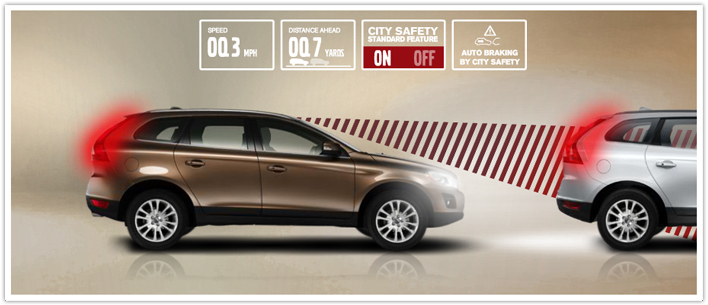For nearly a century, Volvo has been producing automobiles, and almost for the entire existence of the manufacturer Volvo cars have been known for being the safest on the market. This tradition of excellence continues into modern day with the introduction of the Volvo City Safety technology: the newest in groundbreaking technologies helping to preserve not just your car, but also the health of you and your family.
 The core of City Safety is a laser, attached to the back of the rear view mirror and invisible to the naked eye, that scans the area one car length in front of the Volvo automobile. If the sensor notices that the car in front of the driver is stopped or slowing, it has the power to apply the brakes on its own in an attempt to avoid an accident. With a speed difference between the two automobiles of 9 miles per hour or less, City Safety will avoid an accident outright. At speeds of up to 19 miles per hour, it is unable to avoid an accident, but the perfect response time of the system will result in far less damage than sustained with the system keeping watch.
The core of City Safety is a laser, attached to the back of the rear view mirror and invisible to the naked eye, that scans the area one car length in front of the Volvo automobile. If the sensor notices that the car in front of the driver is stopped or slowing, it has the power to apply the brakes on its own in an attempt to avoid an accident. With a speed difference between the two automobiles of 9 miles per hour or less, City Safety will avoid an accident outright. At speeds of up to 19 miles per hour, it is unable to avoid an accident, but the perfect response time of the system will result in far less damage than sustained with the system keeping watch.
There are some limitations on the system: at speeds of 20 MPH or above, City Safety will not automatically apply the brakes, due to the dangers of braking without driver expectation at that speed as well as the risk of false positives when scanning at an increased distance. It will also not notice a pedestrian or other small object in front of the car, limiting only to what it is sure is an automobile.
Nevertheless, the data about City Safety’s effect on the accident rates is in, and it is extremely positive. The Highway Loss Data Institute, the information-gathering arm of the Insurance Institute for Highway Safety, found that automobiles equipped with Volvo City Safety suffer 27% fewer property damage claims than those without, compared with comparable midsize SUVs from other manufacturers as well as Volvo cars without the feature. Even more impressively, bodily injury liability claims were reduced by a staggering 51% thanks to accidents greatly reduced in severity by the earlier automatic braking.
City Safety was introduced in 2010, appearing on Volvo XC60 midsize SUVs with S60 sedans joining in 2011 and XC70 wagons and S80 sedans being equipped for 2012. For the kinds of low-speed impacts that City Safety prevents, human reaction time is one of the greatest challenges; the automatic braking is activated with the instant reaction time of a computer, the driver is not aware it is happening until the accident has already been avoided. The braking power is strong at 50% of maximum in which the driver will receive a jerk forward, but it will never be so violent as to cause him/her to impact the steering wheel or dashboard under normal circumstances. A light on the dashboard will alert the driver after City Safety activates.
Since the laser used is infrared, it is invisible to both the driver and all oncoming motorists – no one will be distracted by a red light flashing in their eyes as you approach. It works equally well in both day and night conditions. Since it only has to read eighteen feet in front of the car, most inclement weather will not affect it, but very heavy rain or snow may impede its performance. It is specially configured to avoid activating when attempting to park or weaving through parked cars, and can be temporarily overridden by pressing on the accelerator – but there is no way to deactivate it for good, as it will turn on again the next time the car is started.
The effects on insurance claims are clear: drivers of Volvos with City Safety file fewer claims and recover less insurance money than those without the feature. Interestingly, even though the total amount claimed for insurance is lower, the amount of the average claim is about 10% higher than other vehicles, which means the system is working. City Safety avoids the small claims for fender benders by avoiding those accidents entirely the claims that do get filed tend to be for more serious damage.
For now, the effect on insurance rates is negligible as the IIHS examines the data, but there is reason to believe you may end up saving on insurance payments in the long run. The National Highway Traffic Safety Institute recently released their own report stating that the system reduces low-speed collision severity and eliminates many collisions entirely, strengthening the argument for reduced insurance payments in the near future.
Regardless of the immediate savings on insurance payments, the time and headaches saved from avoiding fender benders and the additional safety afforded to you and your family make the City Safety technology an invaluable asset in your new Volvo.

